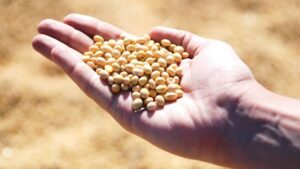That’s the headline from Dan Basse, an economist and founder of AgResource Company. He told attendees at the American Seed Trade Association’s annual Corn, Sorghum and Soybean Seed Research Conference that 2016 was another great year.
“We had record soybean yields and record corn yields,” he said. “It was really farmers only profit if they were able to squeeze any out this year.”
Basse attributes this to what he calls globalization of the world. World agriculture this year looking at the three principle crops (corn, soybeans and wheat) was a record large crop for the third consecutive year, he said. Total world grain supplies were up 95 million metric tons, which increased global grains stocks 24 million metric tons. “The world today is awash in grain,” he noted.
The landscape for farmers here is grim; however, Basse said when he travels to Turkey and visits farmers in Russia or to South America, the smiles on farm faces are everywhere. “They are making lots of money,” he said. “So as you think about the food table … I want you to understand there’s another side of the table.
“It’s due to currency that people are looking more favorably upon their lot in life. Russian farmers are expanding wheat acreage. South American farmers are on their way to producing a record soybean crop this year. And they are all looking at returns ranging between 10 and 30 percent — a much different landscape than we in America are facing today.”
During his hour-long talk, Basse hit upon several factors that influence where agriculture is today, including demand, energy, de-carbonization, inflation, currency, political landscape and more.
In short, he said that regarding demand, the world biofuel market is mature. Additionally, livestock producers have expanded herds, but now face reduced profitability, principally in the United States.
“We’ll see hog prices, chicken prices and as you think about your Thanksgiving table, lower prices than we’ve seen going back 12 years,” Basse said.
Looking at global production compared to global need, Basse pointed out that the world increased harvested acres by 179 million acres in the past 10 years — the biggest increase in history. However, he said the world only needs about 1.8 percent more calories to feed itself each year.
“As you think about that, the world today is producing 2.4 percent more grain, largely due to better genetics, better agronomy and better farming practices,” Basse said. “We are building grain stocks. We are back to that landscape we call 1980 to 2005. It’s a different landscape than where we were in 2005 up to about 2013.”
It’s not just grain that’s oversupplied; energy is, too. “Last week, you basically saw OPEC register its first production cut in eight years,” Basse noted. “Coordinated with the minor producers, it was the first production cut going back to 2001.”
Add to that de-carbonization, an effort to decrease greenhouse gas emissions. “We believe that by 2025, one-third of U.S. cars will be of electric nature,” he said. “If you think about that happening and solar panels on your roof, feeding your house electricity, we start peaking out crude oil demand.”
Moving on to other factors, he explained the world is seeing increased nationalism and pointed to recent events in Italy, the Brexit and the United States. Additionally, inflation is starting to bubble. Basse said this is good news, explaining that it’s the only way to grow your way out of debt over time. Basse said he expects to see improvements for hard assets by late 2017 and early 2018.
In summary, he said the world is producing too much food again today.
“The key question going forward is: ‘Will there be enough economic growth, outside the United States, to sustain the demand?’ We believe this bounce in inflation will cause grain prices to go sideways,” Basse said. “I’m not as bearish on grain this year as I was last year
“But if we have another big harvest in the Northern Hemisphere come July, August, September, we will see prices move down again. But for today, we are cheap enough.”













